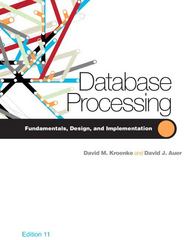Question
The procedure of proof should follow the following format. The answer should like that. Example Proposition: For all integers a,b,c, if a > b and

The procedure of proof should follow the following format. The answer should like that.
Example
Proposition: For all integers a,b,c, if a > b and c
Proof.
(1)Let a,b,c be arbitrary integers, and suppose that a > b and c
(2)From (1), we know that a > b, so a - b > 0.
(3)From arithmetic, we know that a positive number times a negative number is negative.From (2), (a-b) is positive. From (1), c is negative. So (a-b)c
(4)But (a-b)c = ac-bc. From (3), we know (a-b)c
(5)Since ac-bc Prove that the following propositions are true: b) For any two integers and y with different parity (one is even and one is odd), x - y is odd (c) For every integer n, 6n 19 is odd (d) If n is a positive integer and n s4, then n 1)323" (e) For every integer n, 3n 2 is even if and only if n +5 is odd (f) For any integers x and y, max(x,y) + min(x,y) = x + y. rygest talue, min is function that returns the smallest value. (g) If a real number r is not an integer, then there is an integer n in the interval (r- 1,r) Clarification: the interval (r 1, r) consists of all real numbers x such that ax > r- 1 and x
Step by Step Solution
There are 3 Steps involved in it
Step: 1

Get Instant Access to Expert-Tailored Solutions
See step-by-step solutions with expert insights and AI powered tools for academic success
Step: 2

Step: 3

Ace Your Homework with AI
Get the answers you need in no time with our AI-driven, step-by-step assistance
Get Started


